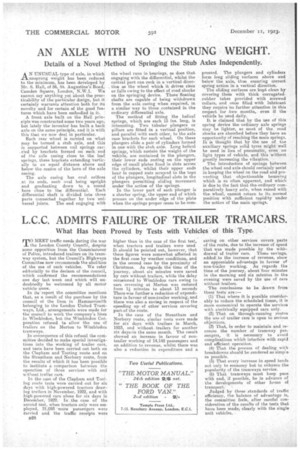AN AXLE ITH NO UNSPRUNG WEIGHT.
Page 12

If you've noticed an error in this article please click here to report it so we can fix it.
Details of a Novel Method of Springing the Stub Axles Independently.
AN UNUSUAL type of axle, in which unsprung weight has been reduce to the minimum, has been developed b Mr. S. Hall, of 56, St. Augustine's Road, Camden Square, London, W.W.I. W cannot. say anything yet about the prae ticability of the particular design, but i certainly warrants attention both for itnovelty and for certain of the good fea tures which have been embodied in it.
A front axle built on the Hall prin ciple was constructed some two years ago but lately the inventor has built a bad axle on the same principle, and it is wit this that we now deal in particular.
Each rear wheel is carried on wha may be termed a stub axle, and thi is supported between coil springs car .ried by brackets formed on each en of the axle casing close to the lea springs, these brackets extending vertie ally to an equal distance above an below the centre of the bore of the axl casing.
The axle easing has oval orifice at, its ends, each oval being uprigh and graduating down to a roan , bore close to the differential. Eac differential shaft is divided into thre parts connected together by two uni versa! joints. The end engaging wit
the wheel runs in bearings, as does that engaging with the differential, whilst the central part can rock in a vertical direction as the wheel whick it drives rites or falls owing to the effect of road hocks on the springing device. Thesefloating shafts are capable of being withdrawn from the axle casing when required, in a similar way to those contained in the ordinary differential axle. The method of fitting the helical springs, which are each 15 ins, long, is interesting. Two tubular plungers or pillars are fitted in a vertical position, and parallel with each other, to the axle case brackets for each wheel. On these plungers slide a pair of cylinders formed in one with the stub axle. Long helical springs, which sustain the weight of the vehicle, are contained in the plungers, their lower ends resting on the upper edge of small plates fixed in slots across the cylinders, whilst their upper ends bear in capped nuts screared to the tops of the plungers, longitudinal slots in the plungers permitting sliding movement under the action of the springs. In the lower part of each plunger is a shorter spring, the upper end of which presses on the under edge of the plate when the springs proper cease to be coin
pressed. The plungers and cylinders form long sliding surfaces above and below the axle, thus ensuring correct spring action in a vertical direction.
The sliding surfaces are kept clean by covering them with thick corrugated.
rubber tubes provided with screwed collars, and once filled with lubricant they require no further attention in this respect. for two months, even if the vehicle be used daily.
It is claimed that by the use of this spring device the ordinary axle springs may be lighter, as most of the road shocks are absorbed before they have an opportunity of reaching the main springs.
It is thought that by the use of the auxiliary springs solid tyres might well be used in lieu of pneumatic, even on light types of vehicle, and this without greatly increasing the vibration.
The introduction of springs between the wheel and axle should certainly assist in keeping the wheel on the road and pre
venting that objectionable botuicing -which is so often apparent, and which
is de to the fact that the ordinary comparatively heavy axle, when raised with the wheel, cannot return to its. normal position with sufficient rapidity under the action of the main springs.
































